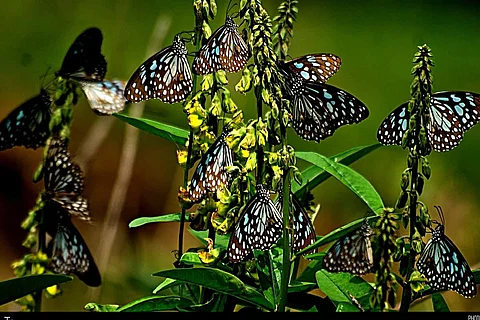

Did you know that the onset of southwest monsoon in Kerala also marks the beginning of butterfly migration season? A group of butterflies from the Western Ghats migrate to different parts of the Eastern Ghats every year, in search of better climatic conditions and then fly back once the monsoon is over.
A group of butterfly enthusiasts in India, mostly from the south, has been dedicatedly tracking this migratory pattern of different species of these insects for the last three years. They have formed a WhatsApp group called Migration India, which has more than 200 members from different states.
“Students in India know about the monarch butterfly migration in America, but they have no clue about what is happening in our courtyard. Records about butterfly migration in India is almost nil, and that is why we formed this group," Kalesh Sadasivan, founder of Travancore Nature History Society and a key member of the group, told TNM.
These migratory butterflies are not rare species that anybody interested could spot them and track them.
“When somebody in our group spots a group of butterflies moving in a particular direction, they would inform on the group. They will give the details about the species, the time they were spotted and the direction they are moving. Once we receive this information, the members in another area will keep track of these butterflies. Thus, like a chain, we track the path of these insects, identify their path and the place of temporary settlements," Kalesh explained.
In the beginning, there were only members from south India but now we have members across India. “But the active members are from Kerala, Karnataka, Tamil Nadu, Goa, Andhra Pradesh and Maharashtra,” he added.
Kalesh and a few others in the group used to volunteer with the forest department for forest surveys, especially for butterfly and other insects surveys. That is how they got in touch with other insect enthusiasts and gradually formed the group in 2017.
“The Common Tiger butterflies, Albatross butterflies and the Common Emigrant are the common migratory species. Insects such as Pea Blue, Dark Cerulean and the Common Banded Awl migrate when they have a population spike," Kalesh explained.
Interestingly, these insects have a common pattern of migration. Only those who regularly track and closely watch them for a few years can figure out the pattern.
“They migrate when the southwest monsoon begins in Kerala, which is in the Western Ghats. Rains are not favourable for these insects. So they migrate to the Eastern Ghats when the monsoon begins and return to the Western Ghats once it is over. Some species like the Common Rose (a swallowtail butterfly) prefer the coastal area as their migration path. They mostly migrate to Sri Lanka. Some other species like the albatross butterflies follow rivers to migrate, while some choose forest edges as their path, and butterflies such as the common crow and tiger butterflies choose valleys in the forest," he elucidated.
Kalesh also explained that it takes about three to four weeks for these winged insects to reach their destination, as noticed by these insect lovers. However, it is not the same generation that comes back. A group of butterflies migrates to the Eastern Ghats, they breed there and the next-generation comes back to the Western Ghats, he said.
The group has archived the data they have acquired so far, and are now working on publishing a scientific paper using the data. “We wanted to collect and include one more year's data but this year, due to the pandemic, we missed some information," he said.
Though the group has started by recording butterfly migration, they plan to extend their efforts to study the migratory patterns of other insects, including dragonflies. For example, Kalesh said, the migration of Pantala flavescens, a species of dragonfly, is one of the biggest insect migration in the world, which happens in India. They migrate from India to Africa. They travel 14,000 to 18,000 kilometres across the oceans.
"In some parts of Kerala, these dragonflies are called Onathumbi. They migrate to Lakshadweep, Maldives and Madagascar. After breeding in these regions, they finally reach the African continent. They then come back to India. They travel mainly through air currents in the ocean. Thirty days is the average life cycle of these dragonflies. So, multiple generations are involved in one cycle of migration," Kalesh said, adding that the group will publish their observations on the topic.